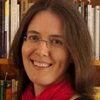Ann-Marie Priest

Ann-Marie Priest is a literary scholar at Central Queensland University and author of My Tongue is My Own: A life of Gwen Harwood (LaTrobe University Press, 2022).
Henry Handel Richardson, author of iconic Australian novels The Getting of Wisdom (1910) and The Fortunes of Richard Mahoney (1917–29), has not fared well at the hands of her biographers. Axel Clark’s account of her early life, though kindly and well intentioned, could not seem to avoid the unfortunate conclusion that Ethel Florence Lindesay Richardson (1870–1946) was a rather unpleasant per ... (read more)
Early in This Devastating Fever, a writer named Alice has a difficult conversation with her agent, Sarah, about the novel she is working on, which she is considering calling This Devastating Fever. The novel is supposed to be about Leonard Woolf, left-wing journalist and activist, novelist, publisher, best-selling memoirist, and husband of Virginia Woolf, whom he outlived by almost thirty years. T ... (read more)
For much of her career, Gwen Harwood (1920–95) was best known for her hoaxes, pseudonyms, and literary tricks. Most notorious was the so-called Bulletin hoax in 1961, but over the years she orchestrated a number of other raids on literary targets, mainly aimed at challenging the power of poetry editors and gatekeepers. For L’Affaire Bulletin (as she sometimes called it), she submitted to that ... (read more)
At first glance, the premise of this book seems dubious. Katharine Smyth, an American woman in her mid-twenties, turns to the life and work of Virginia Woolf for solace after the death of her father. There is no doubt that Woolf writes brilliantly about death, particularly in the novel Smyth focuses on, To the Lighthouse (1927), which fictionalises the death of Woolf’s mother, Julia Stephen. But ... (read more)
Katherine Mansfield is one of those shimmering literary figures whose life looms larger than her work. This is not because her writing lacks value: Mansfield’s spiky and diffuse tales, published in the first decades of the twentieth century, helped reshape our ideas of what short stories are and what they can do. But her life story proved to be even more compelling. As American essayist Patricia ... (read more)
In 1934, Lucia Joyce, then in her late twenties, entered analysis with Carl Jung, at the behest of her father, James Joyce. She had been in and out of psychiatric care for several years, but it was still not clear exactly what was wrong with her – if anything. A few years earlier, as a dancer in the Isadora Duncan style, she had been thought to have a genius akin to her father’s. Her biographe ... (read more)
Resolution is the loosely fictionalised story of Captain Cook’s second voyage, begun in 1772, in search of the mythological Great Southern Continent. Told through the eyes of seventeen-year-old German linguist, artist, and writer George Forster, son of the expedition’s naturalist, Reinhold Forster, it is replete with rolling swells, treacherous reefs, perilous storms, and sightings of unknown ... (read more)
One of the few Australian-born female sculptors of the early twentieth century was a Ballarat girl, Dora Ohlfsen, who went to Berlin in 1892, at the age of twenty-three, to study music and found herself three years later in St Petersburg studying the art of the medallion. She was in Russia because she had fallen in love with the Russian-born, German-speaking Elena von Kügelgen, who had connection ... (read more)
Given the plethora of non-fiction books about Virginia Woolf and her circle, ranging from biographies to memoirs to coffee-table offerings of all kinds, it is tempting to wonder why we need novels as well. For intimacy and immediacy we have the Bloomsberries’ own accounts of themselves in the many voluminous editions of their letters and diaries, not to mention portraits, photographs, and autobi ... (read more)
